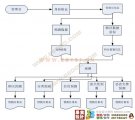摘 要
随着世界经济的全球化、市场的国际化加速,国际化的市场环境要求国内的公众电信运营企业在经营管理上向国外先进的电信运营企业看齐,以迎接电信运营业的国际化竞争。
同时随着国家改革的深化,国内电信业的市场环境已渐趋合理且竞争将日益加剧。国内、国际电信业的如此态势,对公众电信运营企业的服务内容、服务方式、服 务质量、经营管理以及服务意识提出了严峻的挑战。企业的经营模式和服务体系正以客户的价值取向和消费心理为导向,真正体现“创造需求”、“引导消费”的现 代客户服务意识与理念。
在电信企业面向市场、面向国内外众多的竞争者、努力创造更高价值的同时,客户流失的不断增加,客户平均生命周期的不断缩短严重影响了电信企业的 发展。那么,在激烈的市场竞争和不断变化的市场需求面前,如何最大程度的降低客户的流失率呢?常用的方法之一就是利用数据挖掘技术。
数据挖掘技术是目前数据仓库领域最强大的数据分析手段。它的分析方法是利用已知的数据通过建立数学模型的方法找出隐含的业务规则,在很多行业已 经具有成功的应用。在电信行业的应用领域主要有客户关系管理,客户欺诈分析,客户流失分析,客户消费模式分析,市场推广分析等。
在客户数据分析系统中,如何应用数据挖掘技术?主要方式是根据以前拥有的客户流失数据建立客户属性、服务属性和客户消费数据与客户流失可能性关 联的数学模型,找出客户属性、服务属性和客户消费数据与客户流失的最终状态的关系,并给出明确的数学公式。只要知道客户属性、服务属性和客户消费数据,我们就可以计算出客户流失的可能性。市场/销售部门可以根据得到的数学模型随时监控客户流失的可能性。如果客户流失的可能性过高,高于事先划定的一个限度, 就可以通过多种促销手段提高客户的忠诚度,防止客户流失的发生,从而可以大大降低客户的流失率。基于严格数学计算的数据挖掘技术能够彻底改变以往电信企业 在成功获得客户以后无法监控客户的流
失,无法实现客户关怀的状况,把基于科学决策的客户关系管理全面引入到电信企业的市场/销售工作中来。
通常一个完整的数据挖掘过程由业务问题定义,数据选择,数据清洗和预处理,模型选择与预建立,模型建立与调整,模型的评估与检验,模型解释与应用等多个步骤组成。本文将详细论述客户数据分析部分的分类与预测模块。
关键词:数据挖掘,JSP技术,SQL SERVER
The Research and Application of Classification in Telecommunicate Customer Data
Abstract
With the globalization of world economy, speed up the internationalization of the market, the internationalization of the domestic market demand of the public telecommunications operator in the enterprise management to the advanced foreign enterprises in line with the telecom operators to meet the international telecommunications Yunying Ye of the competition.
At the same time as the country's reform deepens, the domestic telecommunications industry market environment and matching the competition will be reasonable and growing. Domestic and international telecommunications industry is such a situation, the public telecom operators business services, service, service quality, management and awareness of service to a grim challenge. Enterprise business model and customer service system are the values and consumer-oriented and truly embody the "create demand", "guide the consumer," the modern concept of customer service and awareness.
In the telecommunications market-oriented enterprises, and the large number of competitors at home and abroad and strive to create a higher value at the same time, the increasing loss of customers, with an average life cycle of constantly shortening a serious impact on the development of telecommunications enterprises. Then, in the fierce market competition and changing market demand before it, how to reduce the maximum degree of customer turnover rate? » One commonly used method is the use of data mining technology.
Data Mining is the most powerful data storage areas of data analysis tools. The analysis method is to use known data through the establishment of mathematical model of the business rules to identify implied, in many industries has a successful application. Application of the telecommunications industry in the area of a major customer relationship management, customer fraud analysis, the loss of customers, customer spending pattern analysis, marketing analysis.
In the customer data analysis system, the use of data mining technology. Main form of ownership is based on previous data to establish the loss of customers, attributes, attributes and customer service consumption data associated with the possibility of loss, the mathematical model to identify customers attributes, attributes and customer service and
consumption data, the loss of the final status of the relationship, And gives a clear mathematical formula. As long as customers know attributes, attributes and customer service consumption data, we can calculate the possibility of loss of customers. Market / Sales based on the mathematical model at any time by monitoring the possibility of loss of customers. If the possibility of excessive loss of customers, higher than the prior designated a limit, you can through a variety of promotional means of improving customer loyalty and prevent the occurrence of the loss of customers, which can greatly reduce customer turnover rate. Based on strict mathematical calculation of data mining technology can completely change the telecommunications business in the past, the future can not be successful, the loss of control, can not achieve the status of customer care, science-based decision-making customer relationship management comprehensive introduction to telecommunications enterprise market / sales In the past.
Usually a complete data mining process from the definition of operational issues, the choice of data, data cleansing and preprocessing, model selection and pre-established model and adjusting the model of assessment and testing, model interpretation and application of a number of steps, such as composition. This paper will be discussed in detail, data analysis and prediction of the classification module.
Key words: Data Mining, JSP technology, SQL,MVC
论文研究主要内容
电信行业客户分析系统属于企业管理信息系统范畴,所以首先来介绍一下信息管理系统的系统结构:管理信息系统主要包括支撑系统和应用系统。支撑系统是由计算机、计算机网络及数据库系统等组成,为应用系统提供运行环境。支撑系统有两种典型的结构形式,即集中式结构和分布式结构。管理信息系统的功能是由应用系统实现的,应用系统的结构应与单 位的结构和管理活动相适应,既可支持各个部门的管理职能,也能支持每种职能不同层次上的管理活动。执行每一种职能都需要一组特写的数据和处理功能,它们便形成了MIS中各个相对独立的子系统。 一个管理信息系统中子系统的设置因不同的企业而异。各子系统之间,借助通信网络与数据库实现互连及数据共享,使整个系统集成为一个有机的整体。每种职能的管理活动一般分为三个层次:运行控制层、管理控制层及战略规划层,管理信息系统的每个子系统均有相应的功能支持这些层次上的管理活动。
另外每个子系统还有 一个事务处理功能,支持最底层的日常例行的事务数据处理。这一层功能涉及的数据量最大,且处理过程是预先确定的,结构化、程序化程度最高。越往上,加工处理的数据越综合,数据量越少,结构化、程序化程度越低。一般的管理信息系统对战略规划层的活动支持较弱,这部分功能将由专门的决策支持系统提供。
本文介绍的客户分类与预测模块介绍:分类与预测功能包含子功能:客户购买产品可能性预测、客户信用预测、客户类别归属预测、客户流失预测和客户欠费可能性预测。
客户购买产品可能性预测功能根据当前购买某产品的客户特征,预测某一客户是否能够买该产品(产品由用户选择)。客户信用预测功能根据当前客户信用好坏的特征预测新来客户的特征。客户类别归属预测功能根据当前不同类别(大客户等)的客户的特征,预测某一新来客户的类别归属。客户流失预测功能根据某一段时间的流失客户特征预测某一客户是否有流失的可能。客户欠费可能性预测功能根据当前欠费客户特征预测某一客户是否有恶意欠费可能。
系统采用TOMCAT作为WEB服务器,SQL Server 2000作为后台支持数据库,通过结合JAVA,JSP,JAVAscript技术创建最基本的系统框架,再结合多种开发软件Eclipse3.1+MyEclipse5.1 、EditPlus、Dreamweave等制作出一套功能比较完善,界面比较美观,使用比较简单的第三方支付系统。
主要业务流程说明:
分类与预测功能包含子功能:客户购买产品可能性预测、客户信用预测、客户类别归属预测、客户流失预测和客户欠费可能性预测。
客户购买产品可能性预测功能根据当前购买某产品的客户特征,预测某一客户是否能够买该产品(产品由用户选择)。
客户信用预测功能根据当前客户信用好坏的特征预测新来客户的特征。
客户类别归属预测功能根据当前不同类别(大客户等)的客户的特征,预测某一新来客户的类别归属。
客户流失预测功能根据某一段时间的流失客户特征预测某一客户是否有流失的可能。
客户欠费可能性预测功能根据当前欠费客户特征预测某一客户是否有恶意欠费可能。
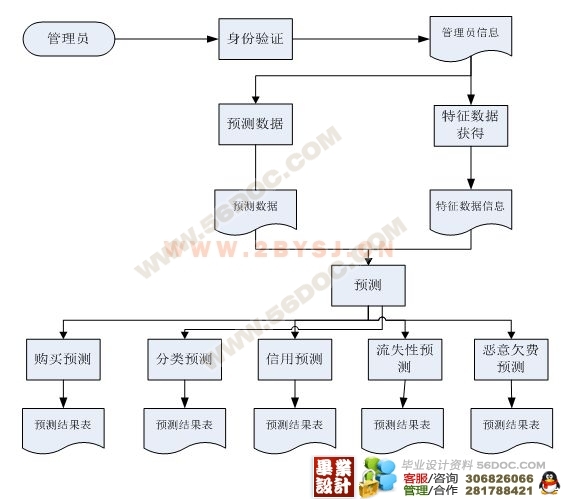
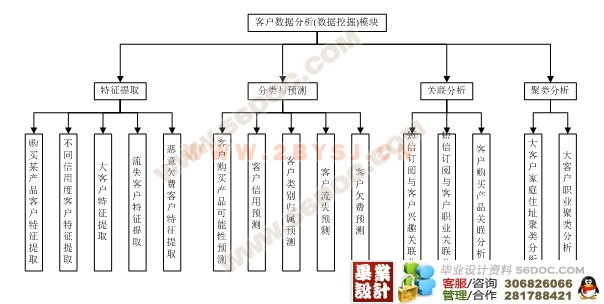
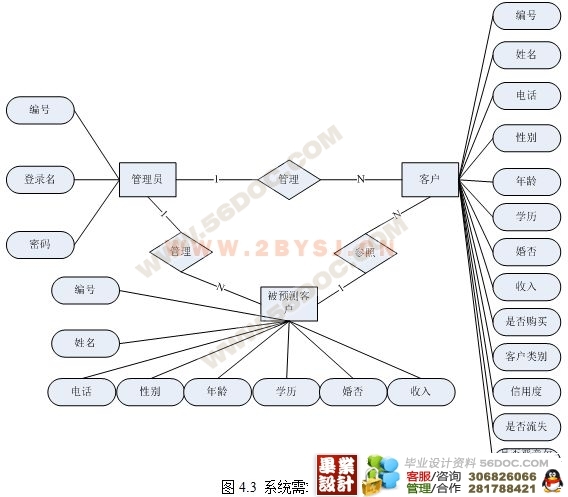

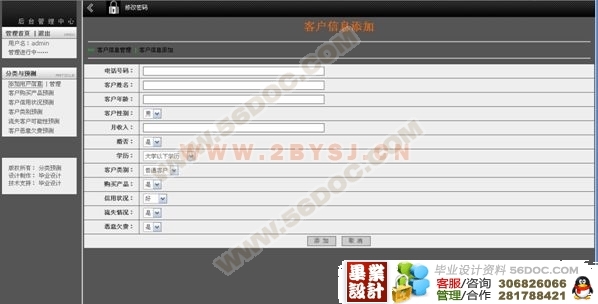
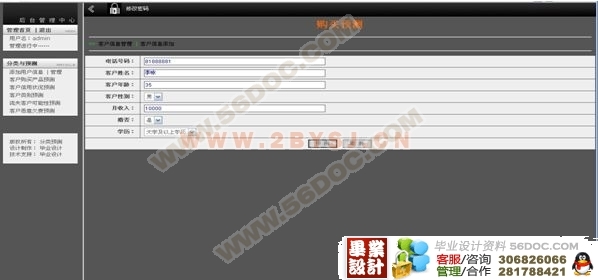
目 录
毕业设计(论文)任务书 I
摘 要 IV
ABSTRACT V
目 录 VI
第1章 绪 论 1
1.1 论文研究主要内容 1
1.2 国内外现状 2
1.3 目的及意义 3
1.4 遇到的困难 4
第2章 关键技术介绍 5
2.1 关键性开发技术的介绍 5
2.1.1 JSP技术介绍 5
2.1.2 J2EE简介 6
2.1.3 数据库技术介绍 8
第3章 系统分析 10
3.1 构架概述 10
3.2系统开发环境 11
3.2.1 用Tomcat来做Web服务器 11
3.2.2用MSSQL作为后台数据库 11
3.3.3用Eclipse3.1+MyEclipse5.1和EditPlus作为程序开发工具 12
3.3 系统业务流程分析 12
3.4系统的数据字典 14
第4章 系统设计 16
4.1 系统概要设计综述与功能模块划分 16
4.1.1 物理环境配制 16
4.1.2 功能模块的设计 17
4.2 数据库设计 17
4.2.1概要设计 18
4.2.2逻辑设计 19
4.2.3物理设计 19
第5章 系统实现 21
5.1 程序模块的具体实现 21
5.1.1 系统登录模块的实现 21
5.1.2 特征数据添加功能 22
5.1.3 客户预测的实现 23
第6章 结 论 25
参考文献 26
致 谢 27
附录一 28 |
